
We’re a planet addicted to our screens. It’s not a new problem — worry about how much television time we clock up has been around since the 1950s — but with so many screens and so many binge-able shows and addictive apps jostling for our attention, it’s no wonder that nearly one in two people in the U.S. say they have an addiction to their digital devices.
For most, screen time is an unavoidable part of the working day. For others, it’s something of an emotional crutch after the workday ends. “People ask me what I’ll be doing tonight and, well it’s a weeknight, so I’ll be doing screens,” jokes one TikTok user in a video that’s garnered nearly half a million likes. “Probably three, as a treat. I like the big one, the medium one and obviously the little one. I find three is best because there’s almost no chance a thought could occur when you get three screens.”
Compared to last year, the average person globally spends three minutes more looking at their screens per day. This compelled us to refresh our 2023 analysis with updated data to answer: in which countries do locals spend the most of their time awake looking at screens? Here’s what we found out.
Outline
Toggle- How We Conducted This Study
- Key Findings
- People in South Africa Spend the Most Time per Day Looking at Screens
- South Africa and Brazil among the Top Countries for Time Spent on Social Media
- The UK Watches the Most Tiktoks
- People in Russia Spend Over a Quarter of Their Day on the Computer
- People in the Philippines Are among the Most Phone-Obsessed in the World
- Saudi Arabia Spends the Most Time Gaming per Day
- The U.S. Comes Top for Most Time Spent per Day Watching TV
- How to Switch Off
How We Conducted This Study
Data analysts at Electronics Hub re-examined how the world spends time in front of their screens in 2024, following on from our similar study in 2023. We used data retrieved from Datareportal’s Digital 2024: Global Overview Report to calculate how much time a local person in each country spends looking at screens as a proportion of the average time per day they spend awake. We also analyzed which countries spend the most time on different devices and different social media platforms.
Key Findings
- South Africans continue to lead the world in screen time, with the average local spending 56.80% of their daily waking hours looking at a screen.
- South Africans are also the biggest fans of looking at their phones, spending 31.72% of their waking hours on them (and using social media the most, too).
- When it comes to television, the U.S. leads — the average American watches TV for 28.35% of their waking day.
- Meanwhile, people in Russia spend the most time of any country on their computers (27.07% of the average local’s daily waking hours).
People in South Africa Spend the Most Time per Day Looking at Screens
The average person in South Africa spends 56.80% of their daily waking hours looking at their screens. That’s the highest proportion of any country, echoing last year’s findings. Here, research has shown that children are exposed to over three hours of screen time outside of school. Another study revealed that children watch more television in neighborhoods known to be dangerous.
Click to open the map in full-size
The United Arab Emirates also ranks highly, a country where the average local spends 49.09% of their waking time looking at screens. The UAE is on the higher end of the scale when it comes to the number of internet users who play video games. The Abu Dhabi-based Unplugged Initiative is one local organization trying to tackle screen and video game addiction in children.
South Africa and Brazil among the Top Countries for Time Spent on Social Media
South Africa comes top again for the most time spent on social media, with the average local spending 22.26% of their waking hours scrolling through the likes of Instagram, TikTok and Facebook, the latter of which is by far the most popular, claiming a 68.35% local market share. Facebook’s popularity transcends borders on the continent, as Nesrine Malik writes for the Guardian:
“To users in volatile economies with disrupted supply chains, Facebook isn’t just useful, it is vital … The company may be in a fight for its life in the west … but in Africa and other regions in the global south, Facebook’s economic, political and social influence almost guarantees it a second life.”
Click to open the map in full-size
Next comes Brazil, where the average person spends 21.48% of their waking hours on social media. Here, the free messaging app WhatsApp and Instagram are the platforms of choice. Mexico ranks not far behind (19.36%), one of TikTok’s biggest fans with a count of 57.5 million local users.
The UK Watches the Most Tiktoks
Speaking of Tiktok, we looked at which countries watch the most videos on the platform. In first place with the highest number of tiks tokked is the United Kingdom, with an average of 154 videos watched each day. This accounts for 10.03% of the time an average person is awake.
There’s a quite significant difference of 12 videos between the first place UK, and second place, USA where 142 Tiktoks are watched daily. However the USA’s position could be poised to change in the coming months as House representatives have supported a bill that could see Tiktok banned.
Mexico and Chile closely follow on the USA’s heels in third and fourth place with 140 and 134 videos, respectively. Mexico seems to be of particular interest to TikTok as they are one of only three countries (alongside Australia and Singapore) in the world that have access to Tiktok’s Spotify rival, Tiktok Music.
People in Russia Spend Over a Quarter of Their Day on the Computer
Turning our attention to computers, we discovered that people in Russia are the biggest users, spending over a quarter (27.07%) of their waking hours on them. For the average local, it’s likely that at least some of that time on the PC is spent gaming: the platform Steam counts 9.5 million users in Russia (the third-highest count of any country in the world), and PC games lead the local market in revenue.
Portugal ranks highly, too: here, locals spend just shy of a quarter (24.10%) of their waking hours on the computer. In Chile (22.20%), which ranks seventh, computers are the second-most frequently used device to access the internet for all age groups. Interestingly, South Korea places very far down in the ranking (15.06%), despite the country’s love of PC bangs (or gaming cafes).
People in the Philippines Are among the Most Phone-Obsessed in the World
Nowadays, you’d be hard-pressed to find anyone on the street in any part of the world without a smartphone in hand — but our next ranking reveals the countries in which the typical resident spends most of their waking hours staring at those pocket-sized screens. The Philippines is the third-most phone-addicted country: here, the average local spends 31.45% of their day on their phone.
When they’re on their phones, people in the Philippines tend to be texting, with the exceptionally high traffic of SMS messages being sent lending the country the title of the ‘texting capital of the world.’ Thailand ranks not far behind the Philippines (30.18%), where one study revealed that the prevalence of smartphone addiction among school children is 52.1%.
Saudi Arabia Spends the Most Time Gaming per Day
Being locked into an addictive video game is one way that someone might easily spend a whole chunk of their day staring at a screen, whether they’re playing a game on a mobile phone, console or PC. In fact, one study revealed that nearly every gamer loses track of time when they’re playing. Saudi Arabia leads the world in video game screen time: the average local games for 10.02% of their waking day.
Research has shown that 5% of adolescents in Saudi Arabia are addicted to video games, a condition linked to high levels of stress. The cultural buzz around video games is highlighted by the government’s decision to invest heavily in game companies and esports. Meanwhile, Vietnam places sixth (7.48%), a country in which games are legally required to time out minors after 180 minutes of play.
The U.S. Comes Top for Most Time Spent per Day Watching TV
The U.S. is the birthplace of television and arguably the most influential country in terms of programming. It’s also the biggest fan of the format: the average person in the U.S. spends 28.35% of their waking hours watching television, the most of any country in the world. When Americans do watch TV, they go all out: the U.S. claims the world’s second-biggest share of binge-watchers (after Sweden).
Most say it’s because they want to view a story all at once, and streaming platforms are only happy to assist in them doing so. It’s part of the business model, explains Pedro Ferreira of Carnegie Mellon University: “Subscription platforms promote binge-watching because it keeps the customer in front of the screen … When one episode ends, the next one automatically starts. Also, the way these stories are written makes them better consumed in this manner. The storytellers take into account that you’re not going to watch one episode per week, you’re going to watch several back-to-back.”
Among the other top TV-addicted nations are South Africa (24.67% of waking hours spent watching it), Brazil (24.15%) and the UK (24.04%).
How to Switch Off
It can be hard to keep track of how much time you’re spending on screens. Certain apps are fine-tuned to be perfect time-sinkers, like TikTok, the second-most downloaded app in the world in 2023. “Like other social media platforms,” writes Sophia Petrillo for the Brown Undergraduate Journal of Public Health. “The infinite scroll and variable reward pattern of TikTok likely increase the addictive quality of the app as they may induce a flow-like state for users that is characterized by a high degree of focus and productivity at the task at hand … Once immersed in the flow-like state, users may experience a distorted sense of time in which they do not realize how much time has passed.”
Some apps and digital devices have safeguards to help you snap out of the tech trance. TikTok, for example, has implemented screen time warnings for users that remind them to take a break from scrolling to go and do something else. Instagram allows you to set screen time limits to help you put down your phone for a breather.
These tools are invaluable if you think you need a bit of help in unplugging from the screen. You might also find it helpful to delete any apps you find you spend too much time on, which you can analyze in the settings of most smartphones. If you find yourself compulsively clicking on a particular app, check out One Sec, an app that gives you the chance to take a breather before launching the problematic app in question.
Methodology
To determine the average screen time by country, we reviewed data from DataReportal (2024) and Sleep Cycle. We ranked countries based on the average daily hours spent looking at screens as a percentage of average waking hours. We also ranked countries based on different types of screen time across different devices and media platforms. Data is correct as of March 2024.

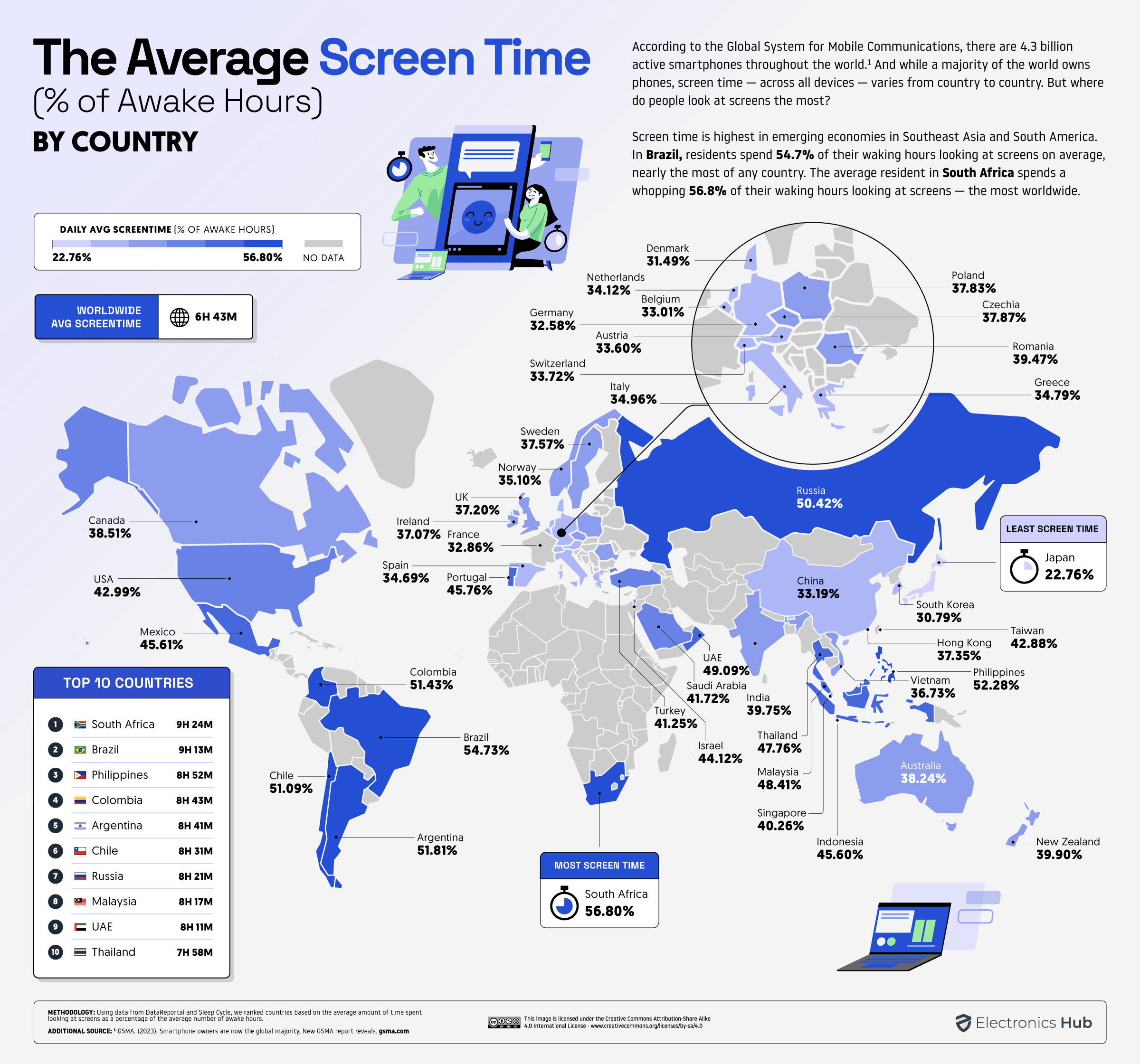
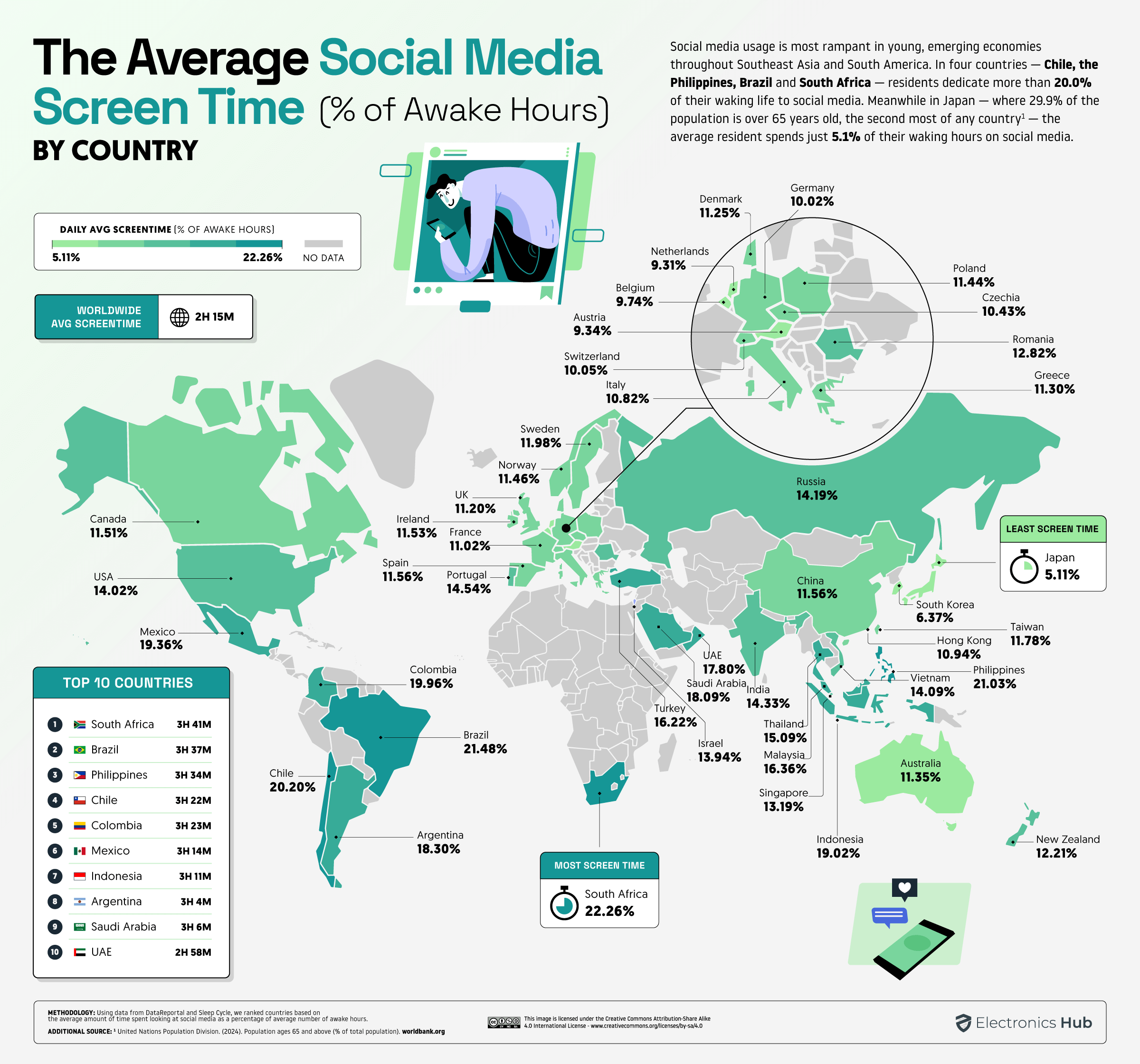
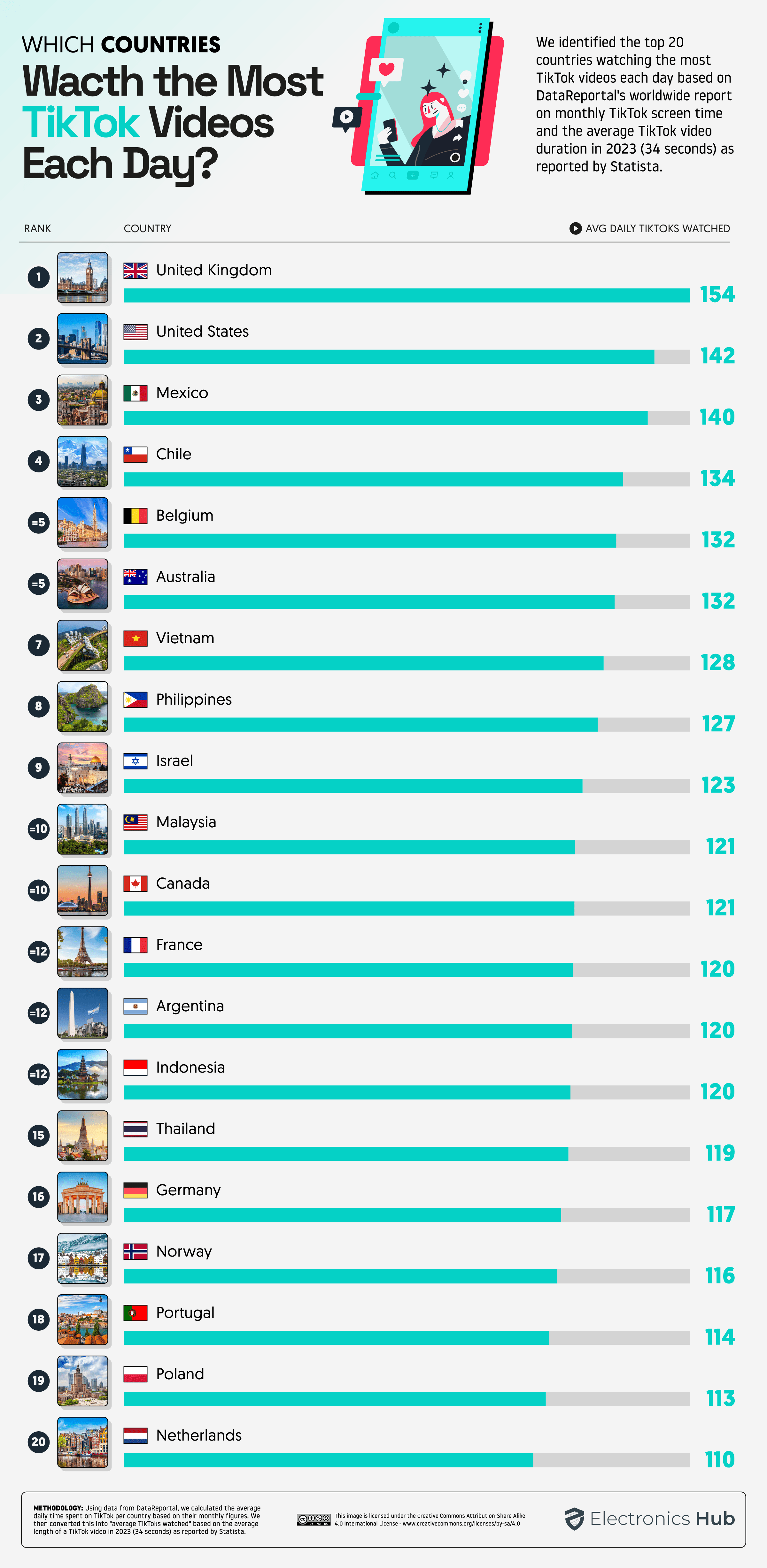
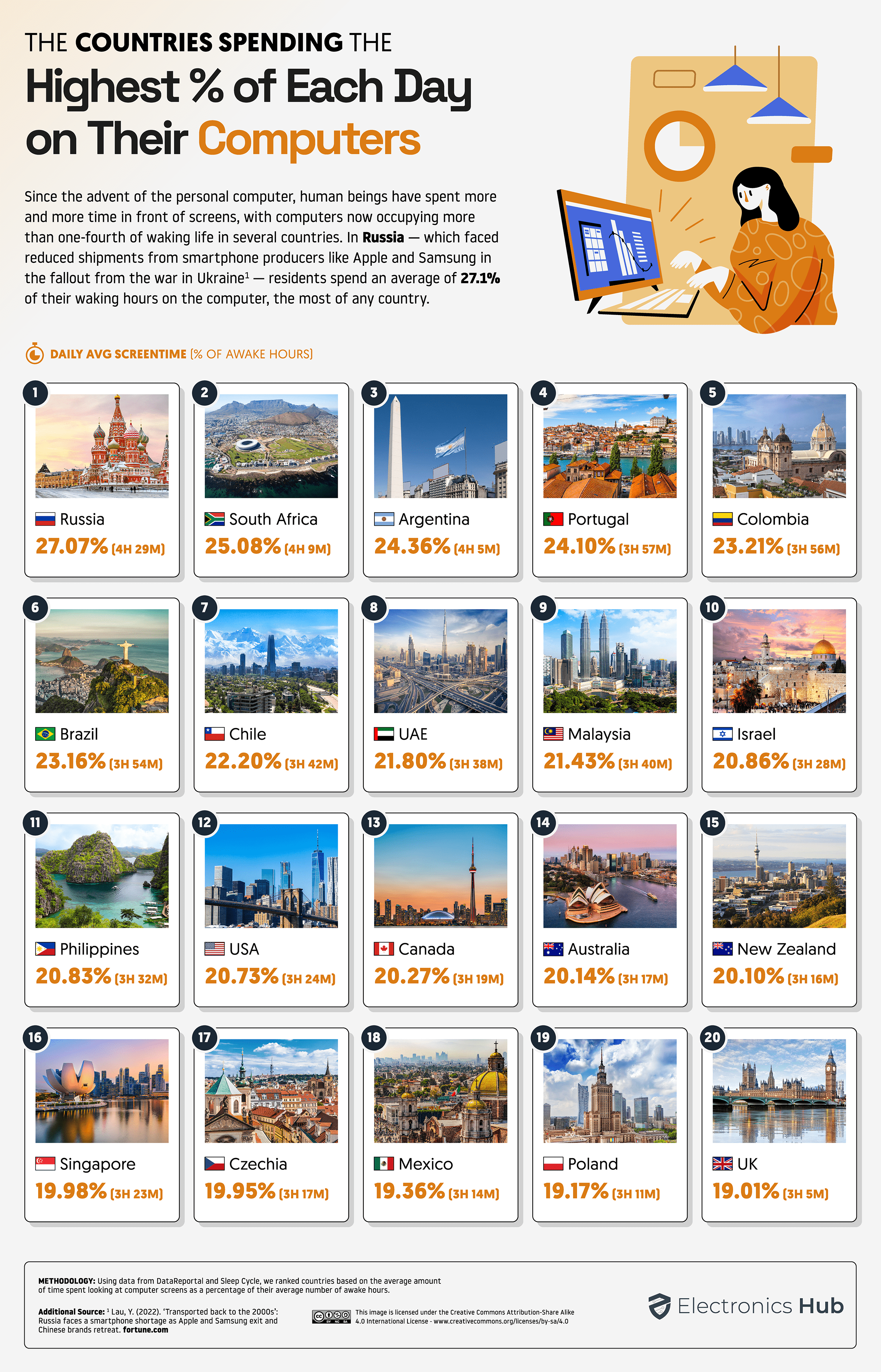
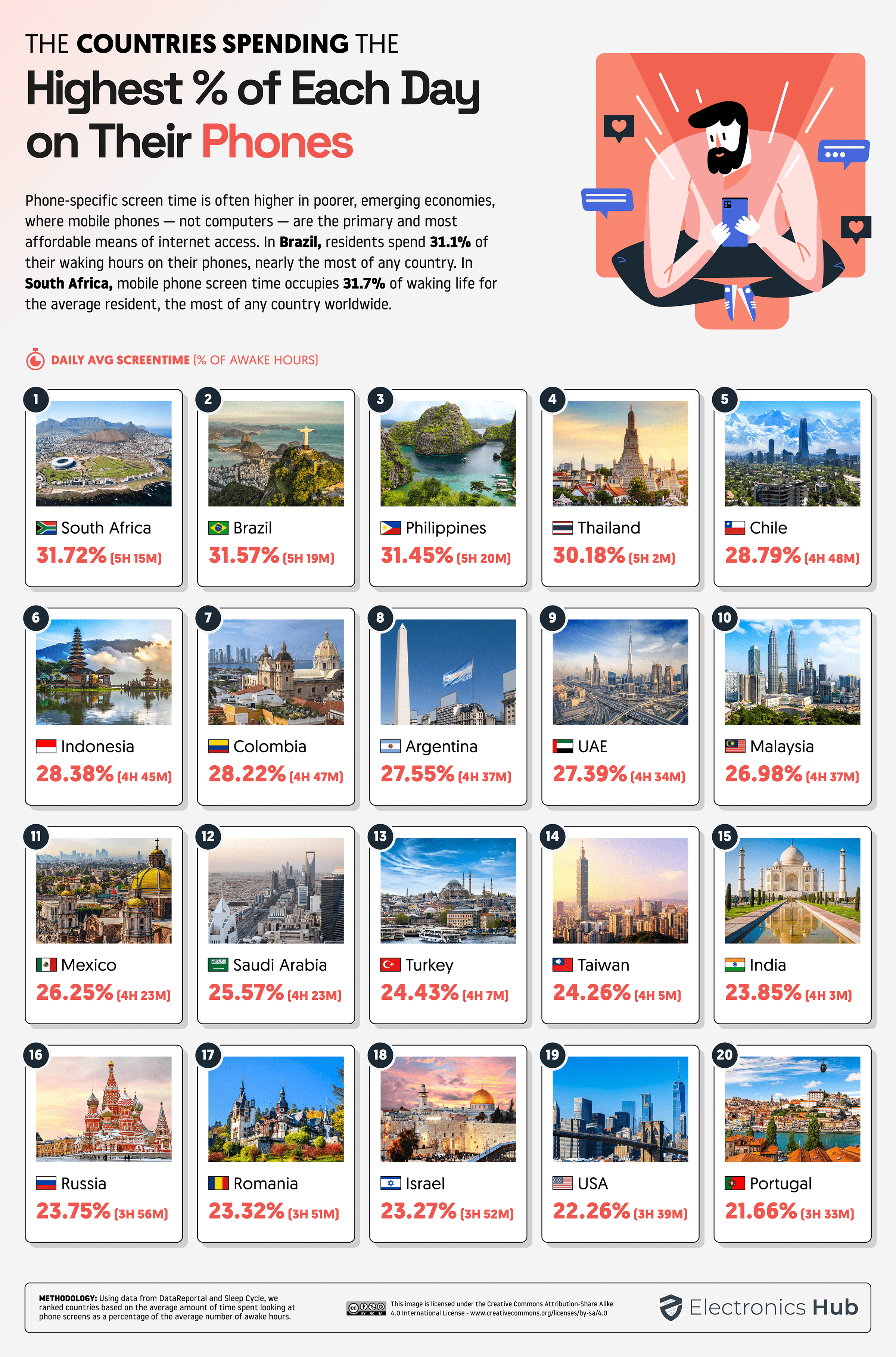
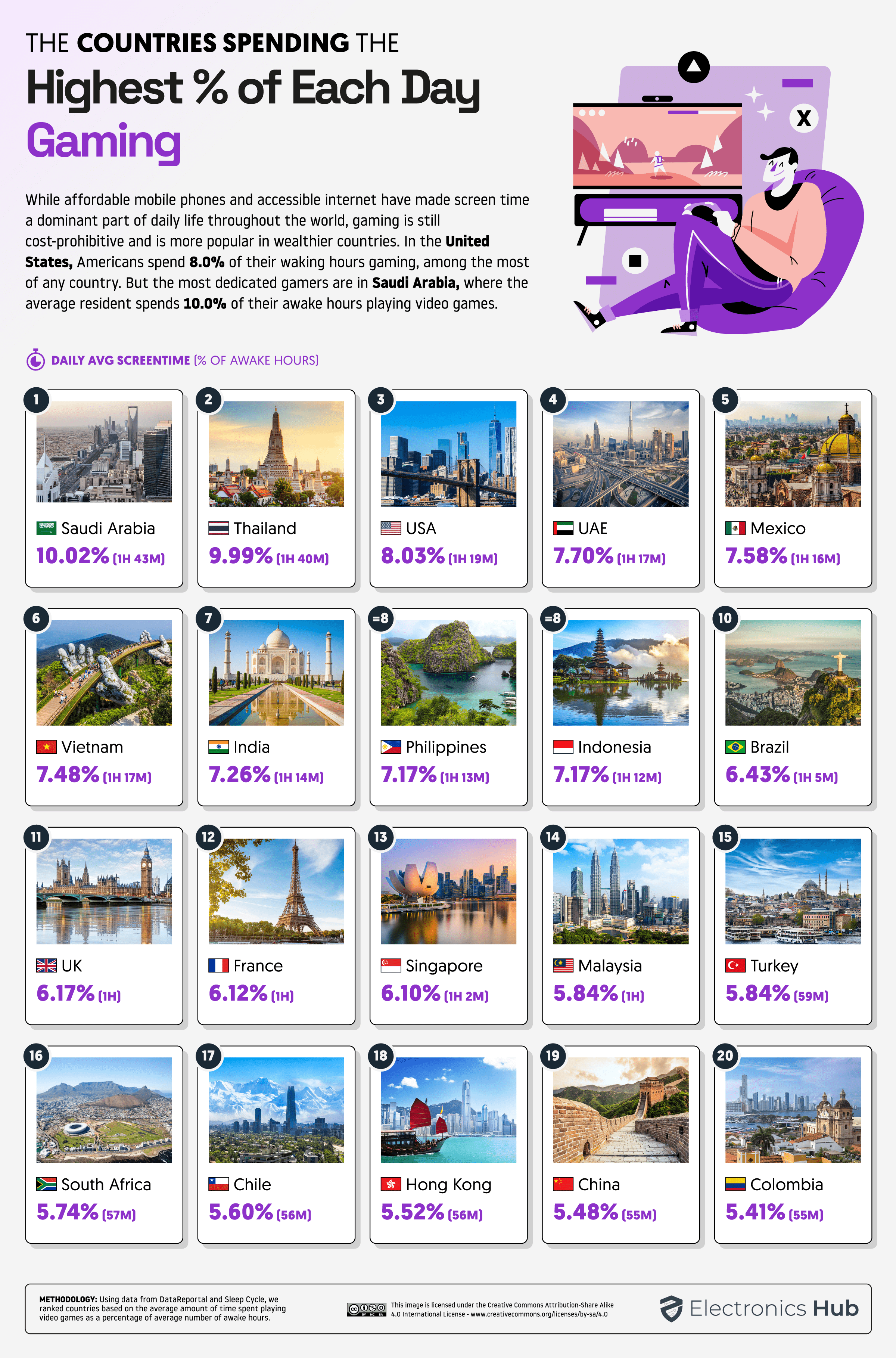
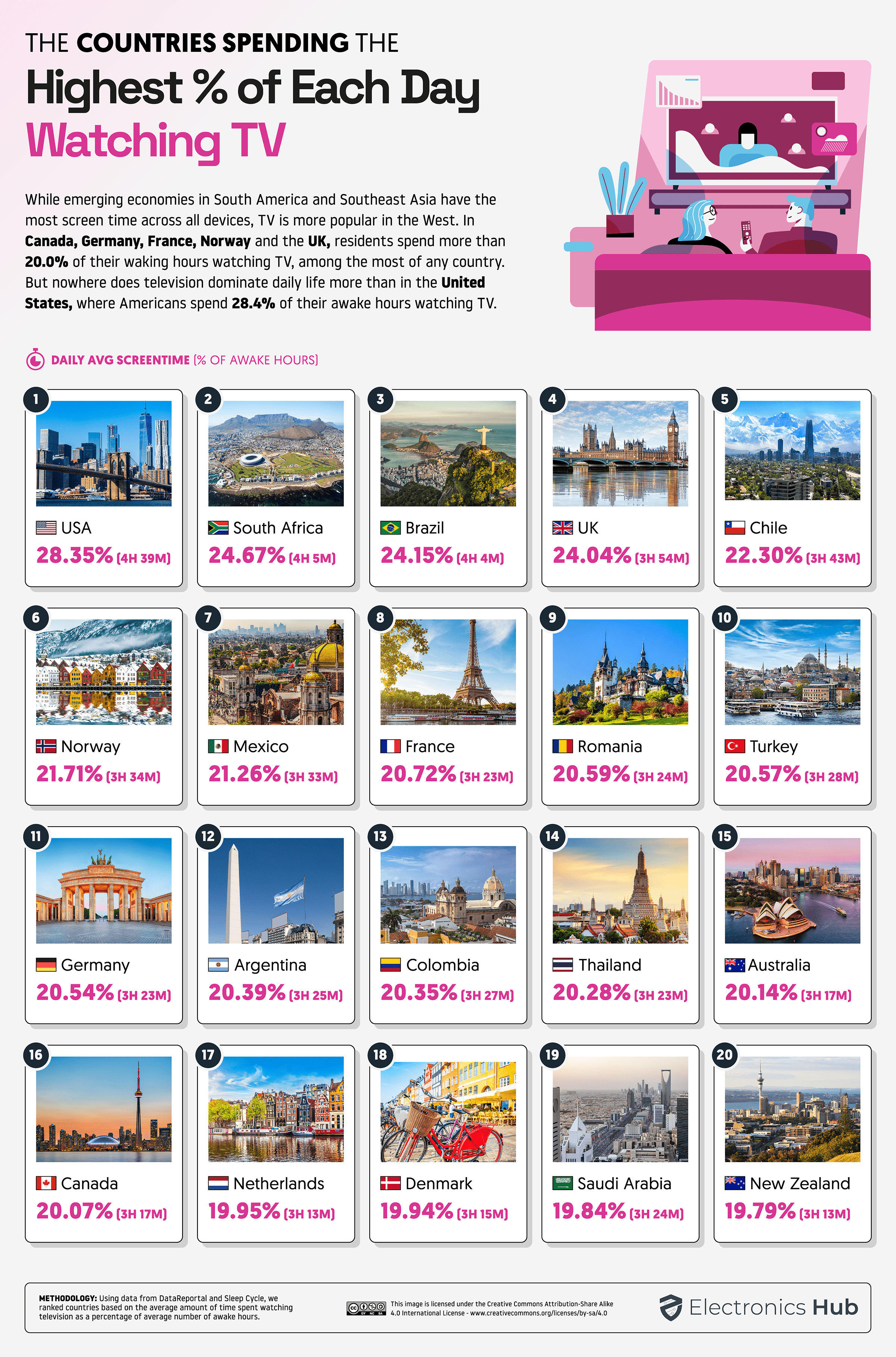

One Response
This article is very helpfull.